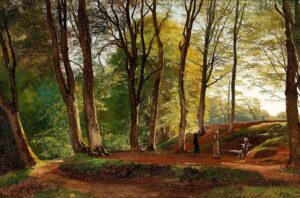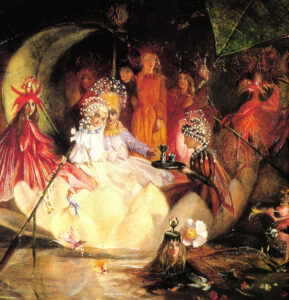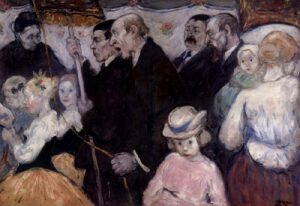Welcome to July. Here is your Convivio Book of Days Calendar for July. It is, as usual, a printable PDF and a fine companion to this blog. Cover star this month: a mid- to late-19th century oil painting called “Summer Day in Sæby Skov with Three Young Ladies Strolling.” It’s a lovely painting with a long title by Danish artist Carl Frederik Aagaard. The trees remind me of woodland strolls in North Carolina and Maine, where the trees are so much different than they are here in Florida.
It is the month of national holidays in Canada and France and here in the US, and of many saints’ days –– Swithin, James, Ann, and Martha, to name a few –– and of the Japanese star festival known as Tanabata. In two days’ time, the Dog Days of Summer will begin, as Sirius begins rising with the sun… and there they will remain with us through the 11th of August. And even in the midst of those often hottest days of summer, the last night of July will bring the Eve of Lammas, the old but little known cross quarter day that reminds us of summer’s fleeting nature, for nothing ever stays the same in the constantly shifting wheel of the year. I’ll visit you as often as I can through this coming month, sharing stories for these days.
SUMMER HIGH FIVE SALE
At the online shop, you’ll find my mom Millie as the cover star for the current HIGH FIVE SALE: Use discount code HIGH5 at checkout for $5 off your purchase of $35 or more. That’s on everything in the shop: our own letterpress printed books and broadsides, genuine Shaker herbs and teas, all of our handmade artisan goods for all the seasons. Plus free domestic shipping when you reach $60. CLICK HERE to shop, and thank you for your support!
A MIDSUMMER NIGHT’S DREAM
It’s not too late to enjoy Shakespeare’s midsummer play (Seth and I are going to sit down and watch the 1999 film version tonight). A week ago, for Midsummer Night, I read an adaptation of “A Midsummer Night’s Dream” for a new video series from the Jaffe Center for Book Arts called Stay Awake Bedtime Stories. I had fun reading the story and you may find it fun to watch. I think it’s about 20 minutes long. Please enjoy it by clicking here.
Image: “Summer Day in Sæby Skov with Three Young Ladies Strolling” by Carl Frederik Aagaard. Oil on canvas, circa mid- to late-1800s [Public domain via Wikimedia Commons].


